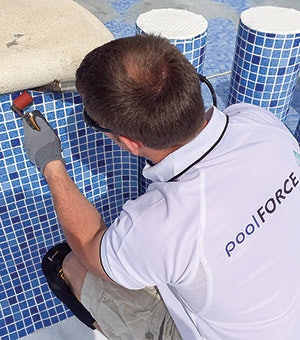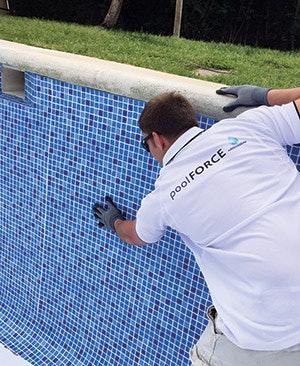The words "vinyl liner" mean different things to different people. For most, the familiar term refers to the colorful, waterproof barrier that hangs from the sides of affordable package pools. But there is another liner application that, while less well known, could serve as an alternative to plaster, exposed aggregate, pool paint or fiberglass as a resurfacing option.
It involves welding 60-mil PVC membranes over a pool's worn out interior surface. The installer uses membrane sheets that are cut to fit on site, welded together using a hot air gun and then adhered to the pool, a process that effectively eliminates the need to precisely measure and pre-manufacture the liner in a factory.
Proponents of the technique claim the 60-mil membranes will last for more than 20 years, which would make them one of the most durable pool surfaces available.
Although the process has been used primarily in commercial pools, manufacturers and dealers focusing on the concept are hoping that it will catch on in the much larger residential market. More common in Europe, the technique has made inroads in Canada, and now a cadre of renovation and service professionals, as well as membrane manufacturers, have their sights set on the U.S.
Here's a look at what some of them have to say.
OLD IDEA, NEW APPROACH
 Liners used for surfacing or resurfacing gunite/shotcrete, fiberglass or stainless steel vessels are manufactured to a durable 60-mil thickness but now also come in colors and patterns that appeal to residential pool owners. Pictured below: Additional steps in the surfacing process. (Courtesy of Elbtal of America)
Liners used for surfacing or resurfacing gunite/shotcrete, fiberglass or stainless steel vessels are manufactured to a durable 60-mil thickness but now also come in colors and patterns that appeal to residential pool owners. Pictured below: Additional steps in the surfacing process. (Courtesy of Elbtal of America)
The welded pool membrane is not a new concept. It began in Europe more than 30 years ago and came to the Americas shortly thereafter. But in the past five years this concept has moved from novel to mainstream, at least for some parts of the commercial market.
"Commercial bids for pool renovations now specify PVC membranes for the renovation of the pool structure," explains Ron Melbourne of Membrane Concepts based in New Bedford, Mass.
In a typical scenario, a public pool that is continuously exposed to freeze/thaw conditions as well as ground movement may potentially crack and leak. Aquatic facility managers are then forced to pay for repairs before they can open for the pool season. Faced with an expensive renovation and the prospect of further repair in the near future, the facility elects to close.
"When you have a pool where the structure is leaking, we have a product that will effectively address that issue with a significant structural renovation," says Richard Story, national sales manager for Elbtal of America, the U.S. distribution firm for Germany's Elbtal Plastics, a 60-mil membrane manufacturer. "Each membrane is tailor-made to fit the exact dimensions of the pool with material that is both flexible and durable.

"It can be a concrete pool, fiberglass or an existing liner pool," he says. "And it can be used in new construction as the original surface, both for the residential and commercial markets."
According to Story and the others contacted for this discussion, more and more aquatic facilities are being introduced to the concept of installing a PVC membrane to make the vessel watertight without having to pinpoint the exact area of the pool structure that is causing the problem.
"Once you have eliminated the leaks in the lines and plumbing, many old pools still have leak problems that are virtually impossible to find," says Troy Fleetwood of Watson Pools in Edmonton, Alberta. "The PVC membrane solves that problem."
"These are pools that often have 3,000 bathers a day and here in Canada, they experience winter temperatures of minus 40 degrees Celsius in the winter and up to 40 degrees Celsius (104 degrees F) in the summer," adds Greg Solmundson, owner of Ark Custom Pool & Spa International based in West Kelowna, British Columbia. "Those annually harsh conditions have made the market ripe for an affordable and reliable resurfacing solution," he says.

EASY DOES IT
The installation process is relatively straightforward: Before lining the pool with the PVC membrane, a "felt-lining" is installed along the floor and walls of the pool structure. The lining is adhered and acts somewhat like a pad under a rug. It protects the pool surface before installing the reinforced PVC lining and later gives the surface a soft, slightly cushioned feel.
After the felt lining is installed, six-foot-wide strips of PVC membrane are rolled out and heat-welded together on site to ensure a perfect, smooth fit. Steps, beach entries, safety ledges and the like are cut, fitted and welded as well.
Some membranes are available with slip-resistant, embossed surfaces, which are generally used on steps. The membrane sheets can be attached to the pool via a bead/channel system, common to standard liner pools, or in the case of the Elbtal product, using a wide adhesive strip.
"The work does require training to ensure you get a beautiful fit," Fleetwood says. "It's true craftsmanship, like a tile-installer. This is especially true for installation of the membrane on steps, beach entry pools, safety ledges, etc."
The average installation of a commercial membrane is just four to five days, so for such pools, the short-term shutdown is often well worth the expense as the facility will no longer suffer through yearly plastering and painting procedures.
Most pools require only a day or less for preparation work before starting the on-site welding of the PVC membrane. "We do run across pools that are in really bad shape, and in those cases we have spent three to four days patching the pool, fixing returns, etc., before laying down the felt and welding the liner in place," Salmundson says, "but that is not the norm. The PVC membrane truly is a long-term solution with minimal installation time."
"There are several approaches to installation," adds Tommy Nachmann, international sales manager at Haogenplast, a supplier of the PVC membrane located in Israel. "We sell this product in over 29 countries around the world, and I have seen many different installation techniques based on the different craftsmanship styles of the installers."
"Once a builder or service tech has determined that this product is appropriate for their business," adds Story, "we offer detailed training because the product is ultimately no good to anyone unless it's installed properly."
HEADING FOR HOME
 Updating a worn-out finish with a 60-mil liner makes sense for clients looking for a clean look without the expense, inconvenience or mess of re-plastering. (Courtesy of 21st Century Pools)
Updating a worn-out finish with a 60-mil liner makes sense for clients looking for a clean look without the expense, inconvenience or mess of re-plastering. (Courtesy of 21st Century Pools)
Today's 60-mil proponents such as Nachmann and Story are targeting residential pool owners who might see the membrane as an alternative for both plaster and traditional vinyl liner style pool linings.
"There's no reason this product can't be used in residential pools," Story says. "In fact, the 60-mil concept is used extensively in residential pools all over the globe except in the United States."
Durability is the key selling point. The PVC membrane has been shown to outlast traditional vinyl with most PVC membranes lasting up to 25 years or more with good pool maintenance, Story says. "This one of the reasons it's also popular in new pools in other parts of the world. If you want a surface that will last for 20 to 25 years, the 60-mil liner is worthy of serious consideration."
THE RENOVATION EQUATION
Todd Shady from 21st Century Pools in New York State started in the industry 25 years ago after learning the trade from a vendor in Germany. He came to view the PVC membrane as ideal for use in high-water tables area where traditional vinyl liners would float and fiberglass would peel.
He is now putting together bids for municipalities, architects and engineers who specify the product. He explains that although the concept was introduced in the U.S. and Canada more than 20 years ago, recently awareness has increased. "Even five years ago we were only installing two to three PVC membranes in pools in a month. Now we install 10 to 15 per month."
Shady explains that it's important for facility managers and even residential pool owners to consider the costs of having to structurally repair their pools year after year versus the cost of installing a PVC liner.
"Surface patches are often not long-term solutions. There may be underlying issues with the structure of the pool that are eliminated by using a PVC membrane to create a complete watertight structure throughout the pool. Shady works with ProLine membrane, based in Pennsylvania, which also has a network of authorized installer-dealers in the U.S. "In our market the majority of the business is still coming from the commercial side of the market although we are starting to see a few residential pool owners opting for the PVC membrane," he says.
Melbourne agrees. The majority of his work is in the commercial arena. Hotel pools and recreational facilities keep Membrane Concepts busy throughout the year.
However, in Canada, Greg Solmundson and Troy Fleetwood are finding that more and more of their jobs are going into the residential market — almost 50 percent in Fleetwood's case.
"We do a lot of business in the Northwest territories," he says. "We have built quite a few new pools using the PVC membrane; it's all been by word of mouth because the PVC membrane works great in that climate."
COSTS AND COLORS
Naturally price is a key factor, for both commercial facility managers and now a growing number of residential clients. "The price of the PVC membrane seems very affordable to most facilities when they compare it to the cost of re-surfacing, re-plastering and repainting the same pool every year over 15 to 20 years," says Melbourne.
"Refinishing plaster pools can be costly and the pools could still leak," Fleetwood says. "And lately we have been having trouble finding plaster do to the repairs, so we are really pushing the PVC membrane as it's a complete waterproofing solution."
As is true of traditional liners, aesthetics are also important. Today's pattern choices have so far trended toward solids, and it's not at all surprising that over the last two years the grey, granite and black colors have become very popular, especially for residential pools. Commercial pools in Canada, where the technique has the strongest following in the Western hemisphere, remain consistently white or light blue to keep the pool water bright and make it easy to see swimmers in the water.
Some commercial and residential pools are adding a tile border or pattern at the top of the wall, but that is still rare in the marketplace.
On top of that, as is true of traditional liners, advocates point out that the membranes are pleasing to the touch. The felt lining under the PVC membrane makes the floor more comfortable to stand on — this is especially beneficial to older bathers using the pool for water conditioning, therapy or aerobics. Small wading pools that use the PVC membrane are a favorite among parents and kids alike, as they love the cushioned feeling of the surface.
THE BUSINESS ADVANTAGE
Pool professionals looking to keep their staff busy year round have reported that adding this service to their repertoire has helped bridge the revenue gap between busy seasons. Once trained in PVC membrane lining, the product can be installed year round on indoor pools and is a great profit center for larger service companies looking to expand their service offering.
Some companies sell and offer the service but outsource the actual installation to companies like Ark Pools in Canada or Membrane Concepts in the U.S. Steve White at Underwater Pools in West Boylston, Mass., is one of those pool professionals who takes this approach. "It's easy to sell the PVC Membrane," he says, "but I don't get enough jobs in a year to justify training and hiring my own staff.
"We take a referral fee from Membrane Concepts, but more importantly it solves a problem with a commercial customer who is also hiring me to do the rest of their renovation. The customer is happy and I continue to service their pool for many more years."
Dan Lenz at All Seasons Pools in Illinois agrees: "We have a huge service and renovation department and know that installing a PVC membrane is exactly what some of our customers need. We work with RenoSys in Indiana who do the membrane installation while we do the rest of the renovation work. Keeping our customers satisfied allows us to maintain the service revenue stream from the client."
In the final analysis, PVC membrane is a product with distinct characteristics and a price point that has to match the customer's wishes in order to secure broader acceptance in the U.S.
"We invite builders and service companies that focus on repairs to simply take a look at the concept and decide if it's right for them," Story says. "We can do new pools, any type of shape and any type of containment system, so we're confident 60-mil liners have a bright future in the U.S. market."
Comments or thoughts on this article? Please e-mail [email protected].












































